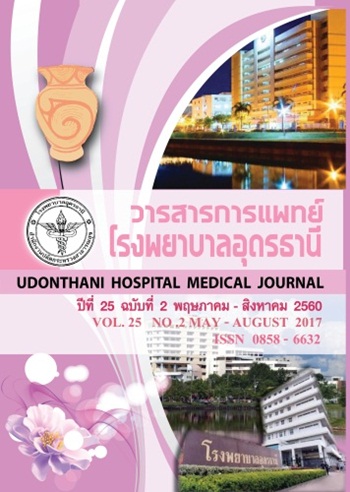การศึกษาเปรียบเทียบผลการรักษาโดยการผ่าตัดใส่เหล็กยึดกระดูกต้นขาบริเวณสะโพกหักผ่านแนวปุ่มกระดูกชนิดมั่นคงระหว่างแผ่นโลหะยึดตรึงกระดูกแบบเกลียวล็อคกับไดนามิกฮิพสกรูในโรงพยาบาลศรีสะเกษ
คำสำคัญ:
กระดูกต้นขาบริเวณสะโพกหักผ่านแนวปุ่มกระดูก, แผ่นโลหะยึดตรึงกระดูกแบบเกลียวล็อค, ไดนามิกฮิพสกรูบทคัดย่อ
ความเป็นมา: กระดูกต้นขาบริเวณสะโพกหักผ่านแนวปุ่มกระดูก (intertrochanteric fracture) อันเนื่องมาจากกระดูกพรุนเป็นปัญหาทางสาธารณสุขที่สำคัญ การรักษามีทั้งการรักษาด้วยการผ่าตัดและไม่ผ่าตัด วิธีการผ่าตัดที่ได้รับความนิยมมากที่สุดและถือเป็นมาตรฐานในการผ่าตัดปัจจุบันคือการผ่าตัดโดยใช้วัสดุยึดตรึงกระดูกไดนามิกฮิพสกรู (Dynamic Hip screw: DHS) อย่างไรก็ตามการผ่าตัดวิธีนี้ก็ยังมีรายงานว่าอาจเกิดภาวะแทรกซ้อนจากการผ่าตัดได้มาก จึงได้มีการพัฒนารูปแบบเหล็กยึดกระดูกรูปแบบอื่นๆขึ้นมาเพื่อรักษากระดูกต้นขาบริเวณสะโพกหักผ่านแนวปุ่มกระดูก การใช้แผ่นโลหะยึดตรึงกระดูกแบบเกลียวล็อค (proximal femoral locking plate: PFLP) เป็นหนึ่งในนั้น อย่างไรก็ตาม ผลการรักษากระดูกต้นขาบริเวณสะโพกหักผ่านแนวปุ่มกระดูกแบบมั่นคงเมื่อเปรียบเทียบกับไดนามิกฮิพสกรูยังคงไม่ชัดเจน
วัตถุประสงค์: เพื่อเปรียบเทียบผลการรักษาโดยการผ่าตัดใส่เหล็กยึดกระดูกต้นขาบริเวณสะโพกหักผ่านแนวปุ่มกระดูกชนิดมั่นคงระหว่างแผ่นโลหะยึดตรึงกระดูกแบบเกลียวล็อคกับไดนามิกฮิพสกรูในโรงพยาบาลศรีสะเกษ
วิธีการศึกษา: เป็นการศึกษาแบบเก็บข้อมูลย้อนหลัง ในผู้ป่วยที่มีกระดูกต้นขาบริเวณสะโพกหักผ่านแนวปุ่มกระดูก ที่เข้ามารักษาใน ร.พ.ศรีสะเกษ ตั้งแต่ 1 มกราคม 2558 - 31 ธันวาคม 2559 โดยใช้ข้อมูลจากเวชระเบียน ฟิล์มเอ็กซเรย์ เพื่อเปรียบเทียบผลการรักษาโดยการผ่าตัดใส่เหล็กยึดกระดูกต้นขาบริเวณสะโพกหักผ่านแนวปุ่มกระดูกชนิดมั่นคงระหว่างแผ่นโลหะยึดตรึงกระดูกแบบเกลียวล็อคกับไดนามิกฮิพสกรูเปรียบเทียบข้อมูลจากทั้งสองกลุ่ม สถิติ ที่ใช้คือ Chi square and Fisher’s Exact probability test ในตัวแปรไม่ต่อเนื่องและ independent student t-test ในตัวแปรที่เป็นค่าต่อเนื่อง และมีค่านัยสำคัญทางสถิติที่ระดับ 0.05
ผลการศึกษา: ผู้ป่วย 95 ราย แบ่งเป็นกลุ่มที่รักษาด้วยไดนามิกฮิพสกรู 59 ราย กลุ่มที่รักษาด้วยแผ่นโลหะยึดตรึงกระดูกแบบเกลียวล็อค36 ราย โดยกลุ่มที่รักษาด้วยไดนามิกฮิพสกรูใช้เวลาในการผ่าตัด เสียเลือดระหว่างการผ่าตัดและสายระบายเลือด ระยะเวลาในการนอนโรงพยาบาล น้อยกว่ากลุ่มที่รักษาด้วยแผ่นโลหะยึดตรึงกระดูกแบบเกลียวล็อคอย่างมีนัยสำคัญทางสถิติ (p - value <0.001, 0.004, 0.015 และ 0.042ตามลำดับ) ในแง่ผลของการรักษากลุ่มที่รักษาด้วยไดนามิกฮิพสกรูจะมีระยะเวลาที่กระดูกติด(healing time)สั้นกว่ามี Harris Hip Scores ที่ 1 และ 3 เดือนเหนือกว่ากลุ่มที่รักษาด้วยกลุ่มที่รักษาด้วยแผ่นโลหะยึดตรึงกระดูกแบบเกลียวล็อคเล็กน้อย แต่ไม่มีนัยสำคัญทางสถิติ
สรุป: เมื่อเปรียบเทียบกับแผ่นโลหะยึดตรึงกระดูกแบบเกลียวล็อคแล้ว ไดนามิกฮิพสกรูยังคงเป็นมาตรฐานในการรักษากระดูกต้นขาบริเวณสะโพกหักผ่านแนวปุ่มกระดูกแบบมั่นคง
เอกสารอ้างอิง
2. Cooper C, Campion G, Melton LJ,3rd. Hip fracture in the elderly; a world-wideprojection. OsteoporosInt 1992;2:285-9.3. Melton LJ,3rd, Riggs BL. Risk factorfor injury after a fall. ClinGeriatr Med 1985;1:525-39.
4. Luukinen H, Koski K, HonkanenR, Kivela SL. Incidence of injury-causing fallsamong older adults by place of residence:a population-based study. J Am GeriatrSoc1995;105:373-86.
5. Weiss NS, Liff JM, Ure CL, BallardJH, Abbott GH, Darling JR. Mortality in women following in hip fracture. J Chronic Dis1983;36:879-82.
6. Bonar SK, Tinetti ME, Speechley M,Cooney LM. Factors associated with short –versus long-term skilled nursing facility placement among community-living hip fracturepatients. J Am Geriatr Soc 1990;38:1139-44.
7. Clawson DK. Trochanteric fracturestreated by the sliding screw plate fixationmethod. J Trauma 1964;4:737-5.
8. Davis TRC, Sher JL, Hersman A,Simpson M, Peter BB, Cheketts RG. Intertrochanteric femoral fractures.Mechanical failureafter internal fxation. J Bone Joint Surg [Br]1990;72:26-31.
9. den Hartog BD, Bartal E, CookeF. Treatment of the unstable intertrochanteric fractures.Effect of the placement of thescrew, its angle of insertion and osteotomy.JBone Joint Surg [Am] 1991;73:726-33.
10. Mainds CC, Neuman RJ. Implantfailure in patients with proximal fracture ofthe femur treated with a sliding screw device.Injury 1989;20:98-100.
11. Watson JT, Moed BR, CramerKE, et al. Medial migration of intramedullaryhip fixation devices: A biomechanical analysis.Arch Surg 1902;36(5):746-61.
12. Gotfried Y. The lateral trochanteric wall: A key element in the reconstructionof unstable pertrochanteric hip fracture. ClicOrthopRalat Res 2004;(425):82-6.
13. Hasenboehler EA, Agudelo JF,Morgan SJ, et al. Treatment of complex femoralfractures with the proximal femur lockingcompression plate.Orthopedics 2007;30:618-23.
14.Zha GC, Chen ZL, Qi XB, et al.Treatment of pertrochanteric fractures with aproximal femur locking compression plate. Injury2011;42(11):155-62.
15. Zhou F, Zhang ZS, Yang H, etal. Less invasive stabilization system(LISS)versus proximal femoral nail anti-rotation(PFNA)in treating proximal femoral fractures: A prospective randomized study. J Orthop Trauma2012;26(3):155-62.
16. Wirtz, C, Abbassi F, Evangelopoulos DS, et al. High failure rate of trochanteric fractureosteosynthesis with proximalfemoral locking compression plate. Injury2013;44(6):751-6.
17. Streubel, P, Moustoukas, M,Obremskey, W. Mechanical failure after lockingplate fixation of unstable intertrochanteric femurfractures. J Orthop Trauma 2013;227(1):22-8.
18. Classifcation/AO OTA. Orthopaedic trauma association fracture and dislocation compendium. J Orthop Trauma2007;21(10):S31-S32.
19. Dripps RD. New classifcation ofphysical status.Anesthesiol 1963;24:111.
20. Harris WH. Traumatic arthritisof the hip after dislocation and acetabularfractures: treatment by mold arthroplasty.An end-result study using a new method ofresult evaluation. J Bone Joint Surg Am 1969
Jun;51(4):737-55.
21. Kyle RF, Gustilo RB, Premer RF.Analysis of six hundred and twenty-two intertrochanteric hip fractures. J Bone Joint SurgAm 1979;61(2):216–21.22. Bendo JA, Weiner LS, Strauss E,et al. Collapse of intertrochanteric hip fracturesfixed with sliding screws. Ortho Rev 1994;(suppl):30-7.
23. Yong C, Tan C, Penafort R. Dynamic hip screw compared to condylar bladeplate in the treatment of unstable fragilityintertrochanteric fractures. Malays orthop J2009;3:13–8.24. Egol KA, Kubiak EN, FulkersonE, Kummer FJ, Koval KJ. Biomechanics oflocked plates and screws. J Orthop Trauma2004;18(8):488–93.
25. Kregor PJ, Obremskey WT, KrederHJ, Swiontkowski MF.Unstable pertrochantericfemoral fractures. J Orthop Trauma2005;19(1):63–6.
26. Whitelaw GP, Segal D, SanzoneCF, Ober NS, Hadley N. Unstable intertrochanteric/subtrochanteric fractures of the femur.ClinOrthopRelat Res 1990;(252):238–45.
27. Rockwood CA, Green DP, BucholzRW. Rockwood and Green’s fractures inadults. 8th ed. Philadelphia, PA: Wolters KluwerHealth/Lippincott Williams & Wilkins; 2015.
ดาวน์โหลด
เผยแพร่แล้ว
รูปแบบการอ้างอิง
ฉบับ
ประเภทบทความ
สัญญาอนุญาต
การละเมิดลิขสิทธิ์ถือเป็นความรับผิดชอบของผู้ส่งบทความโดยตรง
ผลงานที่ได้รับการตีพิมพ์ถือเป็นลิขสิทธิ์ของผู้นิพนธ์ ขอสงวนสิทธิ์มิให้นำเนื้อหา ทัศนะ หรือข้อคิดเห็นใด ๆ ของบทความในวารสารไปเผยแพร่ทางการค้าก่อนได้รับอนุญาตจากกองบรรณาธิการ อย่างเป็นลายลักษณ์อักษร



